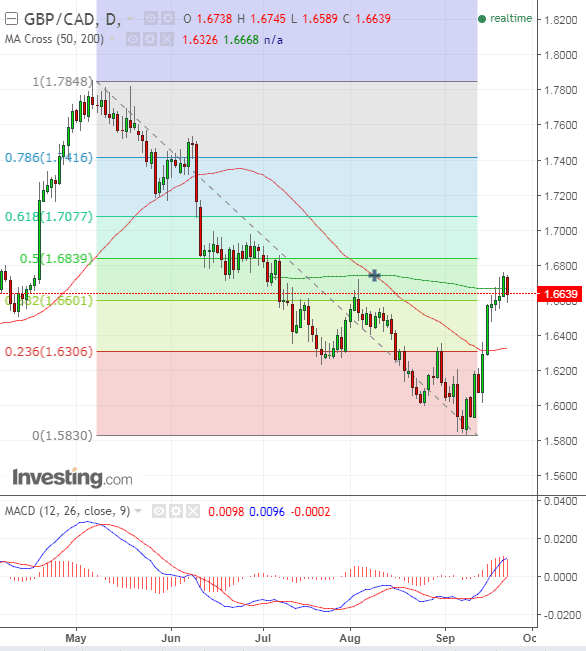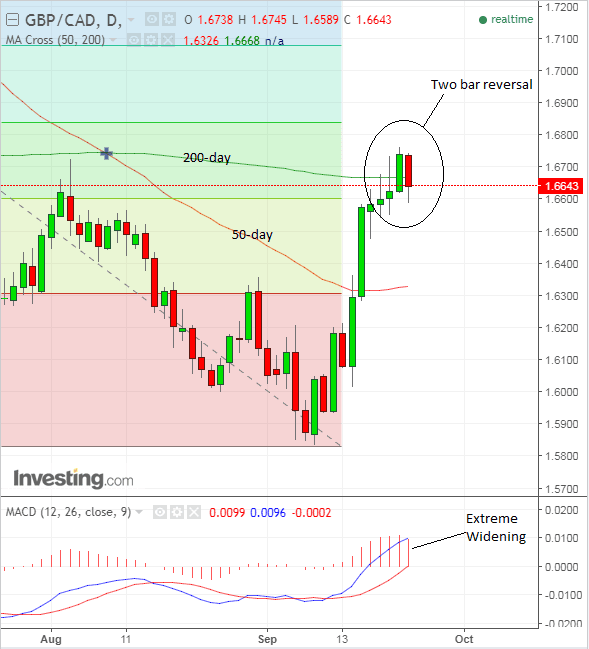Pound-to-Canadian Dollar Has A Rocky Friday; Uptrend Possibly Reversing

The Pound-to-Canadian Dollar experienced a rocky end to the week, and this may be the start of an increase in volatility with deeper declines in the days to follow.
The pair opened in the 1.6730s in the early hours of the morning before selling off down to a low of 1.6612 by 11.30 BST on news that OPEC had reached a loose agreement to cap oil supplies in the year ahead.
Oil is closely correlated to the Canadian Dollar (Loonie) because it is Canada’s largest export, so when oil rose on the OPEC news the Loonie likewise rose; for GBP/CAD this translated into a fall, since the exchange rate is the number of Canadian Dollars afforded by one Pound.
The exchange rate did not stay in the 1.66s for long, however, as traders sold the Loonie heavily after the release of disappointing Canadian Retail Sales data at 12.30.
Canadian data has been exemplary of late so the undershoot which showed sales growth in July of only 0.2% when 0.4% was forecast by most economists, came as a surprise, and led to a sell-off in CAD, and therefore a rise in GBP/CAD.
The exchange rate rose to a peak of 1.6721 at 14.00 before it once again ripped lower in a wave, as traders sold the Pound during and afterTheresa May’s speech in Florence, which revealed scant detail about Brexit.
The Pound lost ground as May failed to allay concerns about Britain’s exit from the EU although she did reveal that there would be a transition period of two years following the official deadline for leaving in 2019, during which EU immigrants would have free movement but that they would have to register with the authorities.
The prime minister also made a proposal to cover the costs of UK-EU commitments although no figures were given.
The pair reached a new day’s low of 1.6589 after the speech although since then the exchange rate has recovered back up to 1.6658.

What is perhaps more interesting, at least from a forecasting perspective, is the picture drawn on the daily chart (see below).
What we have here – in technical speak – is a two-bar reversal, which is when you get a long up bar (green) followed immediately by a long down bar (red).
This pattern is normally a fairly good sign that uptrend has stalled and is about to reverse lower.
It does not necessarily warn of longer-term weakness but it does generally signal at least a relatively modest pull-back.
The fact the exchange rate has also touched its 200-day moving average at the level of the two-bar reversal reinforces the possibility of a pull-back occurring as large moving averages often act as dynamic levels of resistance blocking uptrends and reversing price growth.
A lesser but not inconsequential factor is the 38.2% Fibonacci level (green level) just below the reversal pattern at 1.6601, which is a key retracement level with the potential to act as a trend turning point as well.

This level could act in two ways – either it could act as support to price preventing losses from occurring below 1.6600 or it could more broadly be a level at which the uptrend could be rotating.
Finally, the widening spread of the MACD momentum indicator and its signal line in the bottom panel warns the MACD's rise could be slowing as the spread is likely to narrow, indicating a loss of momentum.
Of course the day has not ended and the two bar reversal would be invalidated by a late recovery in Sterling, however, assuming the exchange rate closes at a similar level to Thursday’s open – roughly between 1.6600 and 1.6650 - the pattern will remain valid and lead to bearish expectations at the start of Monday’s session.
The uptrend since the early September low has been forceful and we don’t necessarily expect a complete reversal and resumption of the longer-term downtrend towards the 1.58 lows and lower again, but it is possible – and it is highly probable that the pair will correct back at the start of next week, or at the very least remain range bound.





